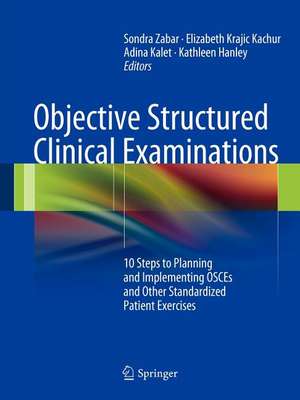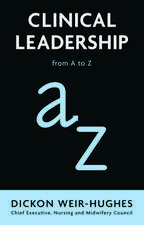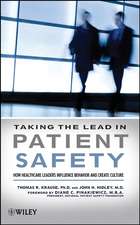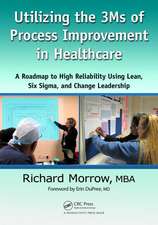Objective Structured Clinical Examinations: 10 Steps to Planning and Implementing OSCEs and Other Standardized Patient Exercises
Editat de Sondra Zabar, Elizabeth Kachur, Adina Kalet, Kathleen Hanleyen Limba Engleză Paperback – 19 dec 2012
Preț: 581.09 lei
Preț vechi: 611.68 lei
-5% Nou
Puncte Express: 872
Preț estimativ în valută:
111.21€ • 115.86$ • 92.46£
111.21€ • 115.86$ • 92.46£
Carte tipărită la comandă
Livrare economică 08-22 februarie 25
Preluare comenzi: 021 569.72.76
Specificații
ISBN-13: 9781461437482
ISBN-10: 1461437482
Pagini: 108
Ilustrații: XIII, 90 p. 16 illus., 1 illus. in color.
Dimensiuni: 210 x 279 x 6 mm
Greutate: 0.45 kg
Ediția:2013
Editura: Springer
Colecția Springer
Locul publicării:New York, NY, United States
ISBN-10: 1461437482
Pagini: 108
Ilustrații: XIII, 90 p. 16 illus., 1 illus. in color.
Dimensiuni: 210 x 279 x 6 mm
Greutate: 0.45 kg
Ediția:2013
Editura: Springer
Colecția Springer
Locul publicării:New York, NY, United States
Public țintă
Professional/practitionerCuprins
PART 1: INTRODUCTION.- Definitions.- Why use SPs and OSCEs?.- History and current use.- How can Standardized Patients and OSCEs satisfy national competency guidelines?.- PART TWO: TEN STEPS FOR ORGANIZING OSCEs AND OTHER SP EXERCISES.- Assemble a team.- Agree on goals and scope and make a plan.- Establish a blueprint.- Develop cases and stations.- Create rating forms.- Recruit and train standardized patients (SPs).- Recruit and train raters.- Manage logistics and implement the program.- Analyze and report data.- Develop a case library.- PART THREE: ADDITIONAL APPLICATIONS OF STANDARDIZED PATIENTS.- Use of standardized patients for remediation.- GOSCEs (Group Observed Structured Clinical Experiences).- OSTEs (Observed Structured Teaching Exams).- Unnanounced Standardized Patients - "The Secret Shopper".- APPENDICES.- Medical error disclosure case.- SP medical error rating form.- Faculty medical error rating form.- Resident evaluation of OSCE experience.- Faculty evaluation of OSCE experience.- SP evaluation of OSCE experience.- Rotation schedule.-
Recenzii
From the reviews:
“This concise guide to the logistical process of instituting a new program outlines 10 steps to ensure a cohesive, well-managed OSCE with verifiable outcomes from start to finish. … this book for medical educators who are developing a new institutional OSCE and/or SP program. … The book is very brief, but the well thought-out appendixes and best practices for program development make it recommended resource for individuals developing new centers and/or programs.” (Rebecca Bowden, Doody's Book Reviews, March, 2013)
“This concise guide to the logistical process of instituting a new program outlines 10 steps to ensure a cohesive, well-managed OSCE with verifiable outcomes from start to finish. … this book for medical educators who are developing a new institutional OSCE and/or SP program. … The book is very brief, but the well thought-out appendixes and best practices for program development make it recommended resource for individuals developing new centers and/or programs.” (Rebecca Bowden, Doody's Book Reviews, March, 2013)
Notă biografică
The editors of this book are experts from NYU Medical School in the field of objective structured clinical exams.
Textul de pe ultima copertă
Objective structured clinical examinations (OSCEs) and other exercises that utilize standardized patients (SPs) can simulate actual clinician-patient encounters with great impact. They are one of the most effective methods for training and assessing competencies across undergraduate, (post)graduate, and continuing health professions education. However, organizing such programs requires strong leadership and the collaboration of many key individuals for planning and implementation. This book, Objective Structured Clinical Exams: 10 Steps to Planning and Implementing OSCEs and other Standardized Patient Exercises, serves as a comprehensive how-to manual and addresses the need for best practice guidelines. It contains a review of relevant literature, pointers for designing OSCE cases, tips on recruiting and training standardized patients, and it describes innovative uses of standardized patients for remediation and assessment in clinical settings. Charts, graphs, and sample forms are included to make this a singular resource for any educator interested in creating or improving OSCEs and other standardized patient programs.
Caracteristici
While there are many resources for students studying to pass an OSCE, there are nearly none for educators who administer OSCEs The only reference that discusses how to implement an entire SP program as opposed to training individual SPs Programmatic and comprehensive, and includes handy charts, tables and forms













